If you’re looking to improve material handling inside your factory or warehouse, an indoor overhead crane could be the ideal solution. It saves floor space, increases efficiency, and fits seamlessly into most building structures. Whether you’re handling heavy machinery, steel components, molds, or daily material transfers, we are here to help you choose the right overhead crane for your facility.
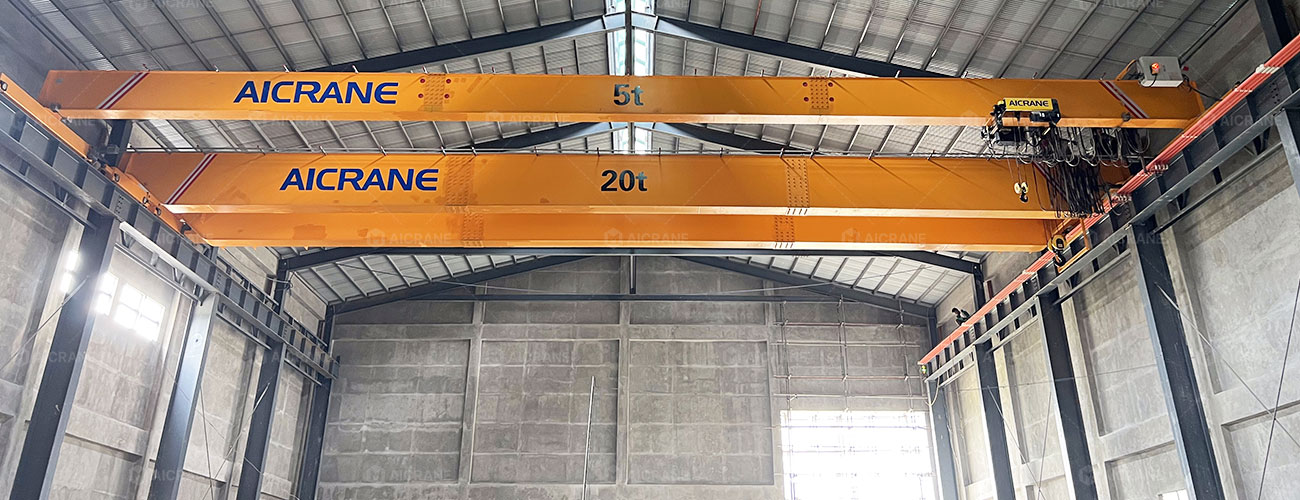
Explore the Types of Indoor Overhead Crane for Your Facility
At Aicrane, we offer a complete range of indoor overhead crane systems designed to meet diverse lifting needs and adapt to different facility layouts and structural constraints.
Single Girder Indoor Overhead Crane – Ideal for Smaller Loads and Tight Spaces
If your lifting needs are light to moderate (up to 20 tons) and your workshop has limited space or height, the indoor single girder overhead crane is a smart, cost-effective choice. It’s quick to install and easy to operate, making it ideal for small to medium-sized facilities.

Single Girder Indoor Overhead Crane Specifications
- Lifting capacity: 5-20t (Customizable)
- Span: 7.5-28.5m (Customizable)
- Lifting height: 6-18m (Customizable)
- Lifting speed: 0.8/5m/min
- Hoist running speed: 2-20m/min
- Crane running speed: 3-30m/min
Double Girder Indoor Overhead Crane – When You Need More Power and Reach
Handling heavier equipment or large spans? This robust indoor double girder crane handles heavier weights (up to 500+ tons) and offers higher lifting heights. It’s perfect for heavy-duty work in factories that demand reliability and strength.
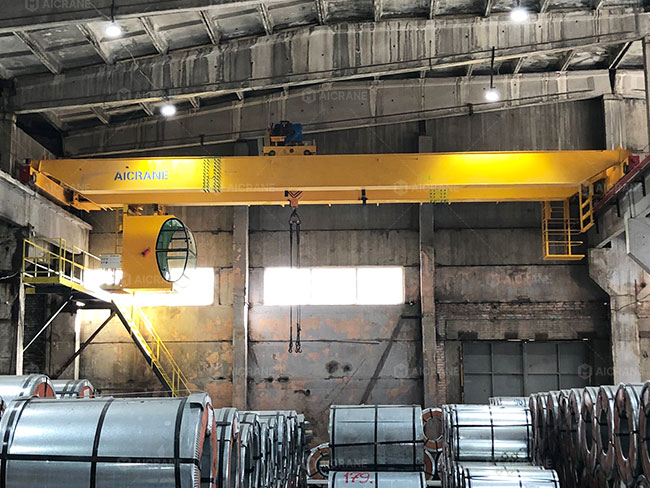
Double Girder Indoor Bridge Crane Specifications
- Lifting capacity: 5-320 tons (Customizable)
- Span: 10.5-31.5m (Customizable)
- Lifting height: 6-24m (Customizable)
- Lifting speed: 0.2-10.7m/min
- Trolley running speed: 2.4-33m/min
- Crane running speed: 4.2-68m/min
Underslung Indoor Crane – Smart Option for Buildings Without Support Columns
No support columns inside your facility or limited roof height for top-running cranes? No worries. Indoor underslung cranes are installed below the runway beams, making them ideal for buildings without column supports or with low ceilings. They save valuable space and offer flexible, efficient lifting for light to medium loads.
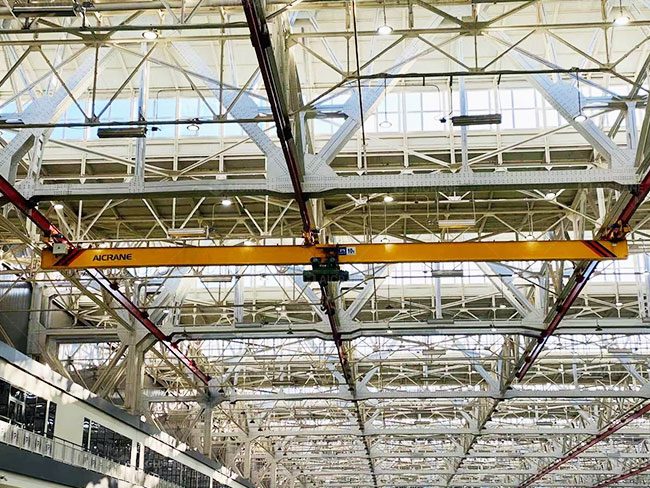
Underslung Indoor Crane Specifications
- Lifting capacity: 1-10 tons (Customizable)
- Span: 3-22.5m (Customizable)
- Lifting height: 6-30m (Customizable)
- Lifting speed: 0.7-8m/min
- Hoist running speed: 20m/min
- Crane running speed: 20m/min
Each type of indoor overhead crane offers distinct advantages based on your facility’s layout, lifting requirements, and operational workflow. Whether you’re working with low ceilings, handling heavy-duty loads, or aiming to optimize floor space, selecting the right crane type is key to long-term efficiency and safety.
So, how do you determine which solution fits your facility best? Let’s explore how to choose the most suitable indoor overhead crane for your specific needs.
How to Choose the Right Indoor Overhead Crane for Your Facility
Unlike outdoor or open-yard lifting applications, inside overhead crane selection is heavily influenced by spatial constraints, building structure, workflow integration, and operational precision. Here are some important factors to consider when selecting an overhead crane for indoor use.

Start with Your Indoor Environment
When choosing an indoor overhead crane, your facility layout should take priority. Key facility-based constraints include:
- Clearances (floor to ceiling, crane runway to roof, hook approach zones)
- Column spacing and structural supports
- Existing mezzanines, HVAC systems, or lighting installations
- Floor space restrictions and aisle traffic
Choose the Right Configuration for Headroom and Space Optimization
Indoor cranes often need to maximize vertical and horizontal working space. Consider:
- Low Headroom Hoists: For facilities with limited height, choose low-headroom designs that reduce the distance between the trolley and hook.
- Underhung (suspension) cranes: These are ideal for tight clearances as they hang from the ceiling structure and eliminate the need for floor columns or runway beams.
Tip: Don’t over-spec the crane – balance capacity and reach with spatial economy to preserve production efficiency.
Determine the Required Lifting Capacity
While it may be tempting to ”oversize” your crane, indoor systems should be optimized for actual load profiles:
- Determine your typical load weight and maximum occasional lift.
- Consider load handling frequency – a 10 ton overhead crane used constantly may need a higher duty cycle than a 15 ton crane used sporadically.
In confined indoor areas, oversized overhead cranes often reduce maneuverability and safety.
Integration with Production Flow and Safety Zones
Indoor bridge cranes must work in harmony with your process layout. Consider:
- Will the crane span the full width of the workshop or just localized zones?
- Do you need precise load positioning for assembly tasks or just simple transfer?
- Should the system be integrated with conveyors, robots, or other machinery?
Also factor in walkways, safety clearance zones, and operator visibility. In indoor settings, human-robot-machine coordination is tighter, so safety systems like anti-collision devices, overload limiters, and remote controls are even more essential.
Control Systems and Accessibility
Indoor overhead cranes often require fine motion control due to the proximity of other structures and people. Evaluate:
- Radio remote control vs. pendant control vs. cabin control
- Need for variable frequency drives (VFDs) for smoother operation
- Synchronization with other cranes or hoists
Additionally, in indoor spaces with restricted access, consider how maintenance personnel can safely access crane components for inspection and repairs.
Crane Runway Installation Challenges in Existing Facilities
One of the most overlooked issues in indoor overhead crane projects is retrofitting into an existing building. Key questions:
- Can the roof or existing steelwork support a top running system?
- Do you need to add or reinforce runway beams?
If structural reinforcement is required, that will affect both budget and project timeline. In leased or temporary buildings, indoor mobile gantry cranes such as rubber tyred gantry cranes may be more practical.
Compliance and Noise Considerations
In enclosed spaces, environmental factors are amplified. Consider:
- Noise levels – quieter electric hoists are preferable for indoor work.
- Dust, fumes, or temperature extremes – choose appropriate motor protection ratings and enclosures (IP ratings).
- Local compliance standards – indoor industrial cranes often fall under strict regional safety and operational regulations.
Selecting the right indoor overhead crane requires more than choosing the right load capacity or span – it demands a detailed understanding of how the crane will interact with your building structure, production processes, and operational constraints.
To better illustrate how these principles apply in real-world situations, let’s look at a few successful indoor overhead crane projects we’ve delivered for our customers.
Cases: How Our Indoor Overhead Cranes Fit Each Facility Perfectly
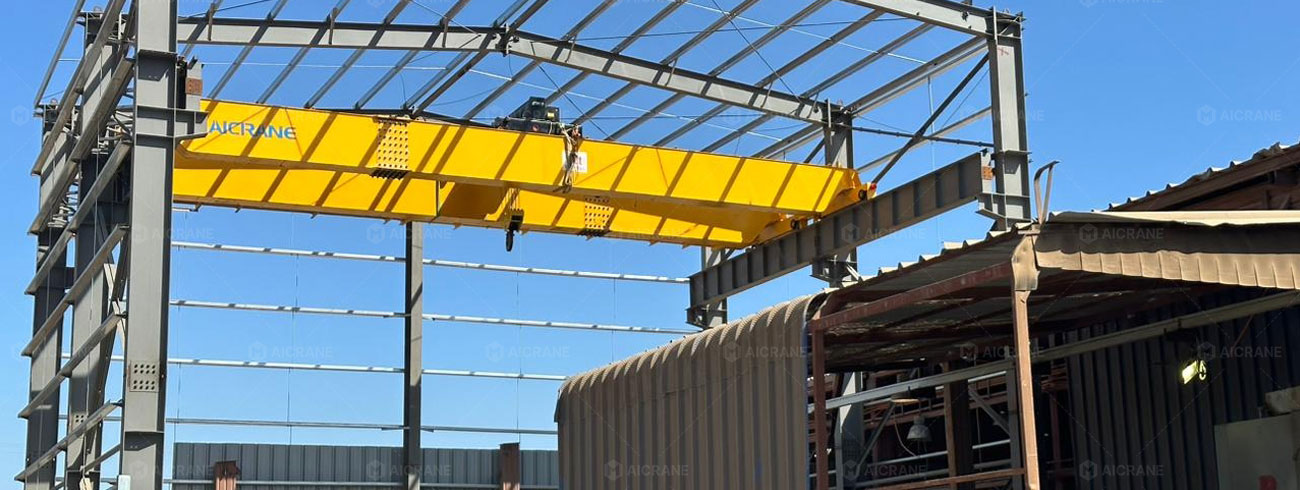
Indoor Overhead Crane and Steel Structure for Mining Workshop in Chile
Challenge:
A Chilean mining service company needed a heavy duty indoor crane to lift and service crushing equipment. However, their current work area was covered by only a lightweight shed, which could not support an overhead crane. They planned to expand the workspace and required both the crane and the supporting steel structure.
Aicrane Solution:
We provided a 32-ton double girder indoor overhead crane with a 14-meter span, along with the steel structure for the new workshop area. During consultation, we learned the client planned to install a second crane in the future. To accommodate this, we adjusted the column and runway beam specifications to ensure long-term structural compatibility.
Result:
The indoor crane system fully met the client’s initial needs for handling and maintaining mining equipment. They were also highly satisfied with the quality and adaptability of the steel structure, which lays the foundation for future crane expansion.
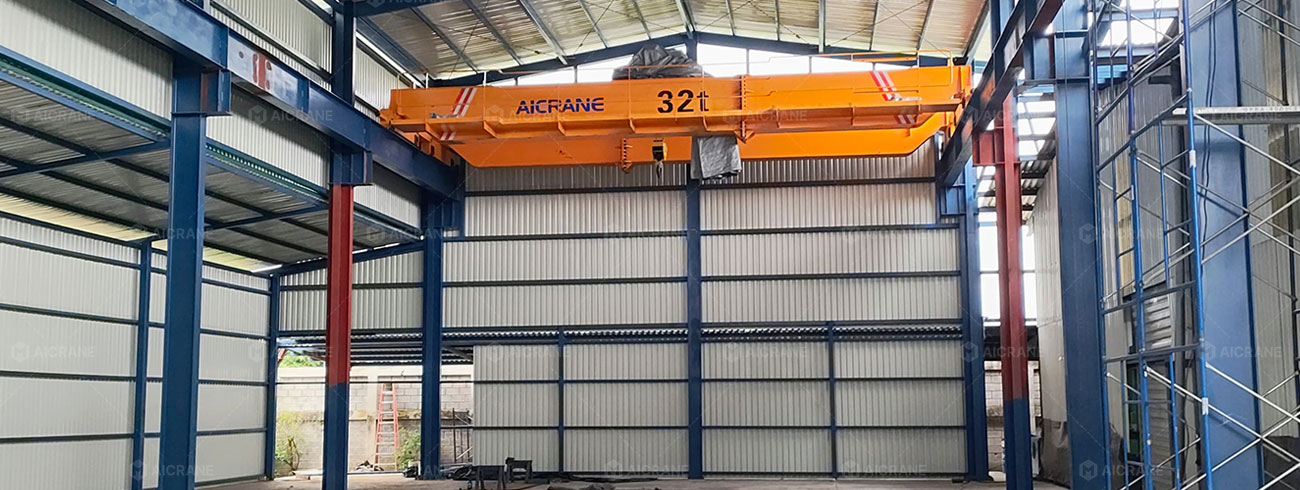
Custom Indoor Overhead Crane Matches New Facility Design in Costa Rica
Challenge:
Our client, a precision machining and equipment maintenance company in Costa Rica, faced difficulties aligning the crane specifications with the steel structure design when building a new production facility. Their engineers lacked the data needed to size columns and roof beams for the intended crane system.
Aicrane Solution:
After receiving the full set of building drawings, our engineering team proposed a 32 ton double girder indoor overhead crane with a 12-meter span, and provided precise structural load data. This helped the client’s team optimize their steel structure for full compatibility.
Result:
The integrated indoor crane system greatly improved indoor handling efficiency, enabling the facility to process larger precision components and take on more high-value orders.
Feel free to contact us to learn more about our indoor overhead crane projects. We’ll be happy to provide detailed project information and customized solutions to help you choose the most suitable lifting system for your indoor use.
Indoor Overhead Crane Installation: What You Need to Know
Installing an indoor overhead crane raises important questions about complexity, facility modifications, and the support you will receive. Here’s a clear overview to help you understand the process and plan accordingly:
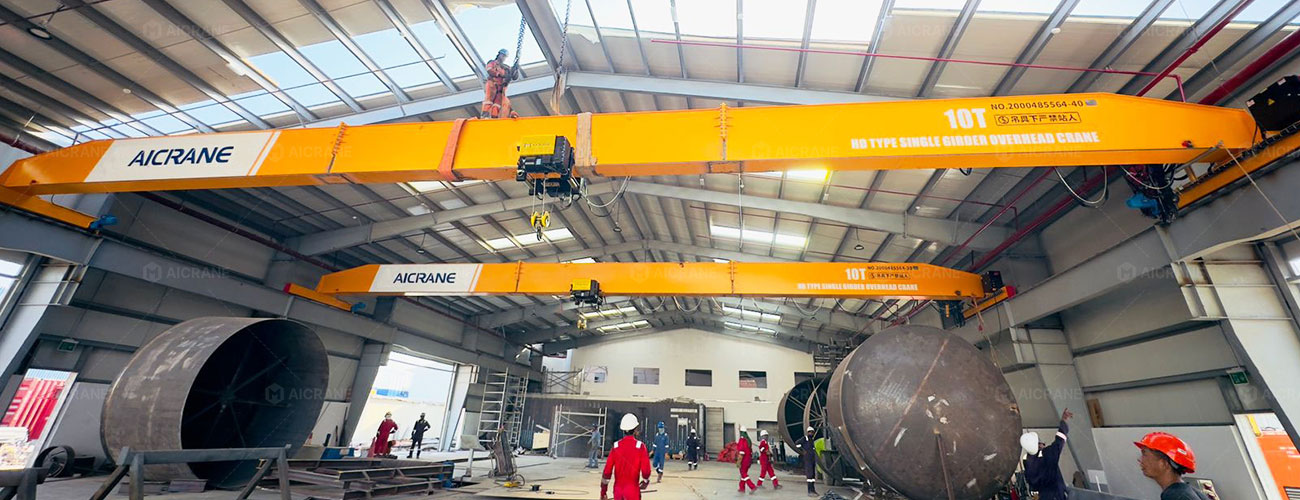
Can I Install the Crane in My Existing Facility?
Yes, many of our indoor overhead cranes are designed specifically to fit existing facilities. These cranes work with your current roof structure and maximize your facility’s space without requiring large-scale building changes.
We provide expert evaluation to recommend the right indoor crane type for your facility.
Is the Installation Process Complex?
The complexity depends on your facility’s current structure and the indoor crane type.
- Single girder and underslung cranes usually have simpler, faster installations.
- Heavy-duty double girder indoor cranes or installations in older buildings may require more preparation and professional expertise.
Will My Facility Need Structural Modifications?
- If your building has strong roof supports and sufficient headroom, usually no major modifications are necessary.
- For buildings lacking strong beams or with low ceilings, we recommend underslung cranes or low headroom cranes that adapt without costly renovations.
- In some cases, reinforcements may be needed – our engineers will assess your building and advise you clearly.
What Is the Typical Installation Process?
- Site Inspection and Preparation: Checking structural readiness and clearing installation areas.
- Runway Beam and Rail Installation: Installing or verifying support structures with precise alignment.
- Crane Assembly: On-site assembly of bridge, trolley, and hoist components.
- Electrical Wiring and Controls: Connecting power and configuring crane operation systems.
- Testing and Commissioning: Load testing and operational checks to ensure safety and performance.
- Operator Training: Teaching your staff safe operation and basic maintenance.
Do You Provide On-Site Installation or Remote Guidance?
- We offer professional on-site installation services with experienced teams to ensure smooth setup.
- For customers with qualified local technicians or remote locations, we provide remote installation guidance and support.
Our goal is to make installation as seamless and cost-effective as possible for you.
With Aicrane tailored support and flexible installation solutions, setting up your indoor overhead crane, whether in a new facility or an existing structure, is made simple and efficient.
Once installed, the next critical step is ensuring your team can operate the crane safely and effectively. Let’s explore the control options available and how to choose the right one for your operational needs.
How to Operate an Indoor Overhead Crane: Control Methods Explained
Aicrane offers multiple control options to suit different working environments and operator preferences – all designed to ensure safety, precision, and efficiency inside your facility.

Pendant Control – Simple and Cost-Effective
Pendant control involves an operator walking alongside the indoor bridge crane and operating it via a handheld push-button controller attached to a cable.
- Suitable For: Light-duty to medium-duty applications, smaller workshops, or facilities with limited headroom.
- Advantages: Easy to learn and cost-effective; no need for extra cab or radio systems.
- Limitations: Operator movement is limited by cable length; not ideal for long travel distances or large workshops.
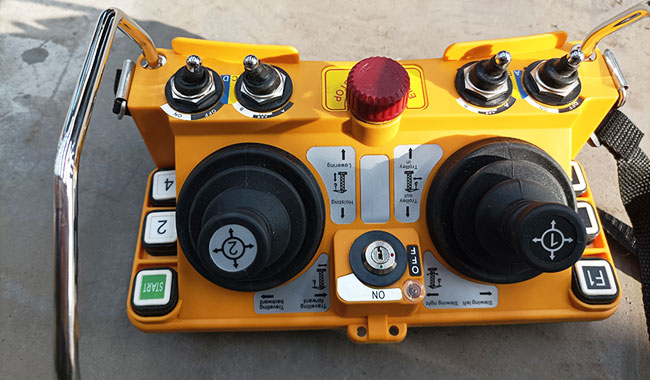
Wireless Remote Control – Flexible and User-Friendly
Wireless remote controls allow the operator to control the crane from a safe distance using a handheld transmitter.
- Suitable For: Medium to heavy-duty applications, when flexibility and operator safety are priorities.
- Advantages: No physical tether; excellent visibility and mobility for the operator; enhances productivity.
- Suitability: Ideal for indoor crane users who want to keep distance from the load or operate across multiple work zones.

Cabin Control – For Heavy-Duty, Long-Span Indoor Cranes
Cabin control places the operator in a cab mounted on the crane itself.
- Suitable For: Large-scale industrial facilities or operations requiring full visibility over long spans and heavy loads.
- Advantages: Precise control for complex operations; suitable for heavy duty overhead cranes.
- Considerations: Higher installation and operation costs; may not be necessary for standard indoor applications.

Smart Control Options – Toward Intelligent Crane Operation
Aicrane also supports advanced control solutions such as semi-automated or fully automated systems, depending on your operation needs.
- Remote monitoring and diagnostics
- Anti-sway and positioning systems
- Integration with factory MES or ERP systems
Which control option is right for your facility? Choosing the appropriate control method depends on several key factors: the size and layout of your facility, weight and frequency of lifting, operator skill level and safety requirements, budget, and future automation goals.
No matter which control system you choose, our engineering team will help tailor the operation method based on your workflow, facility layout, and staff preferences.
Integrated Solutions: Indoor Overhead Cranes & Steel Structure Workshops
When planning or upgrading your indoor material handling system, it’s crucial to consider not only the crane itself but also the building structure that supports it. At Aicrane, we don’t just provide high-quality indoor overhead cranes, we also design and supply customized steel structure workshops perfectly tailored to your crane and operational needs.

Why Combine Steel Structure Buildings with Indoor Overhead Cranes?
Optimized Structural Support: Steel structures can be engineered specifically to support the loads and dynamic forces of indoor overhead cranes, ensuring safety and longevity.
Maximized Space Utilization: Our steel workshops are designed with optimal clear spans and appropriate headroom, providing ideal conditions for crane operation without unnecessary columns obstructing workflow.
Customizable Layouts: Whether you need single or multiple indoor cranes, long spans, or specific lifting heights, we tailor the steel frame to integrate seamlessly with your crane specifications.
Faster Construction and Cost Efficiency: Prefabricated steel structures allow quick erection, minimizing downtime, and reducing overall project costs.
By combining our durable steel structure workshops with expertly engineered indoor overhead cranes, you ensure your facility is optimized for maximum efficiency, safety, and long-term performance.
Ready to build a facility that perfectly supports your indoor overhead crane operations? Contact Aicrane today for a free consultation and custom design tailored to your project requirements. Let’s create the ideal environment and indoor lifting systems for your lifting and production success.


